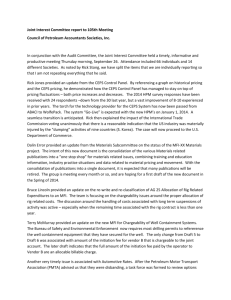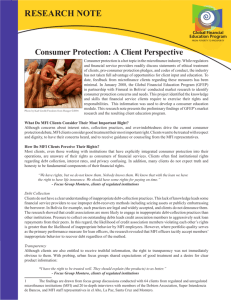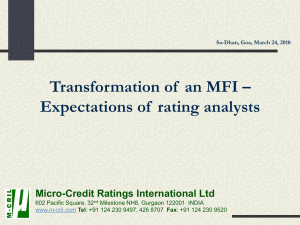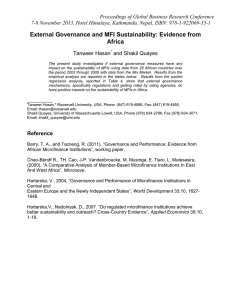Multicultural Fluency Institute I, 2009 David Mengel Department of History
advertisement
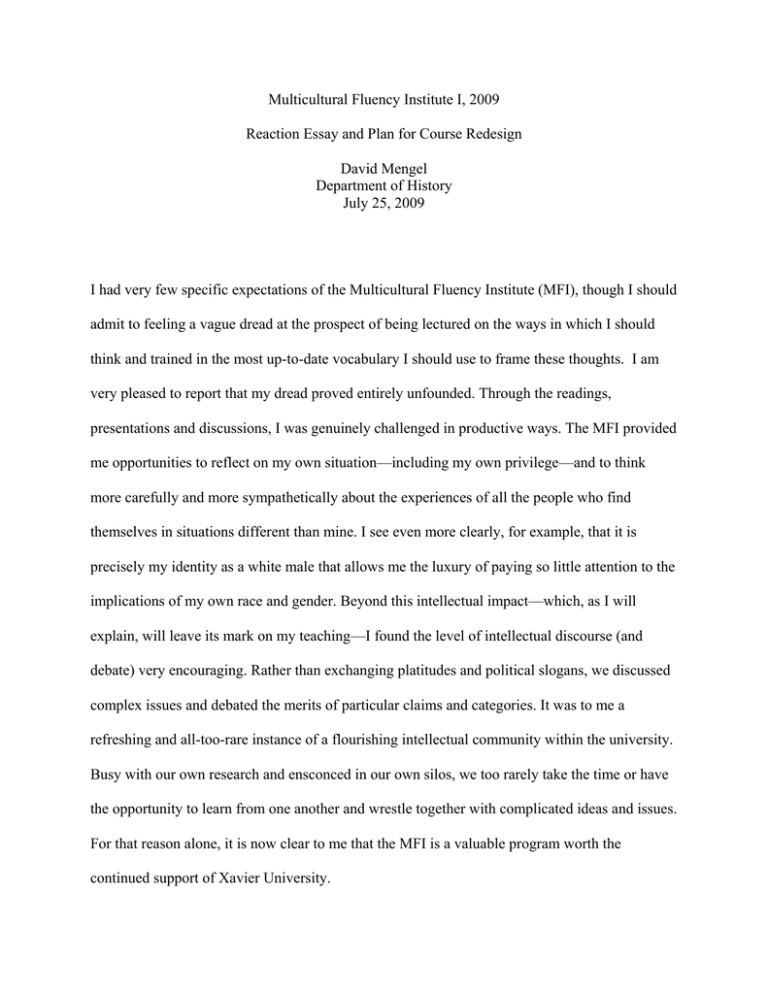
Multicultural Fluency Institute I, 2009 Reaction Essay and Plan for Course Redesign David Mengel Department of History July 25, 2009 I had very few specific expectations of the Multicultural Fluency Institute (MFI), though I should admit to feeling a vague dread at the prospect of being lectured on the ways in which I should think and trained in the most up-to-date vocabulary I should use to frame these thoughts. I am very pleased to report that my dread proved entirely unfounded. Through the readings, presentations and discussions, I was genuinely challenged in productive ways. The MFI provided me opportunities to reflect on my own situation—including my own privilege—and to think more carefully and more sympathetically about the experiences of all the people who find themselves in situations different than mine. I see even more clearly, for example, that it is precisely my identity as a white male that allows me the luxury of paying so little attention to the implications of my own race and gender. Beyond this intellectual impact—which, as I will explain, will leave its mark on my teaching—I found the level of intellectual discourse (and debate) very encouraging. Rather than exchanging platitudes and political slogans, we discussed complex issues and debated the merits of particular claims and categories. It was to me a refreshing and all-too-rare instance of a flourishing intellectual community within the university. Busy with our own research and ensconced in our own silos, we too rarely take the time or have the opportunity to learn from one another and wrestle together with complicated ideas and issues. For that reason alone, it is now clear to me that the MFI is a valuable program worth the continued support of Xavier University. Mengel, MFI report, p. 2 That is not to belittle the importance of multiculturalism, both as lived experience and as academic concept. Neither type of multiculturalism can be ignored in the 21st-century university. Both characterize our academic culture. I signed up for the MFI with the knowledge that I had reflected too little and too unsystematically on the place of multiculturalism in my own classes. So from the beginning of the week’s sessions, I had begun to think about ways that the MFI might influence my courses. The application is not immediately obvious: my research focus is medieval European history, and nearly all of the courses I teach relate to pre-modern Europe. Medieval European history and place is correctly perceived to have been written by the most privileged in society—literate Christian men or those with the political power to command such men. The foundational narratives of courses such as Western Civilization (since relabeled and reimagined as European History at Xavier) have traced the triumphs of European ideas and principles over the world. Of course we have all long since moved away from this explicit narrative. For example, many recent historians sought to revisit the Middle Ages, asking questions about the underrepresented perspectives of women and the marginalized, including Jews, heretics and homosexuals. Such laudable goals are inevitably limited, however, by the lack of historical evidence: recognizing that women’s voices were only rarely preserved in writing unfortunately does not help us to recapture most of those lost voices. Unwritten books remain impossible to read. Still, we have done what we can. Like other historians, I have already incorporated some of the rare texts of women writers into my courses. In addition, my students already study the experience of Jews, of persecuted heretics and of prostitutes in medieval society. We also consider how the formation of the concepts—such as “Christendom”—that defined majority identities in pre-modern Europe at the same time strengthened the exclusion Mengel, MFI report, p. 3 and even persecution of those people marginalized by these concepts. After participating in the MFI, I am sure that my own presentation of some of this material will be increasingly nuanced; otherwise those courses on the Middle Ages will not change significantly. I do, however, expect to make significant changes to my European History II course, which focuses on 16th- to 20th-century Europe. Most of the students in this class are undergraduates in their first or second years. A small minority of them are History majors; most take the class in partial fulfillment of the History requirement of Xavier’s core curriculum. Students earning a Masters of Education who want to teach pre-collegiate History (Social Studies) also take this class. Each Spring, I teach two sections of 31 students of this class. For this reason, the changes made to this course will have an impact on a broader and larger group of students than will changes to any of the other courses I teach. Specifically, the changes will affect both the character of the narrative I develop in my lectures and the readings I assign. I recently decided to adopt a different, shorter textbook; that will now allow me to assign more primary texts—texts, in other words, written in the times that we are studying. These texts become the foundation for our class discussions, so we explore them in much greater depth than we do the textbook’s narrative. I will continue to use the same published collection of primary texts. I especially like it because, in comparison with traditional “readers,” it reprints longer (often 20-30 pages) and complete texts (including letters and essays). Time constraints still make it impossible to assign all of the texts in this long book—that was, in fact, the editor’s expectation. Since the MFI finished, however, I have been reading some of the texts which I have never assigned. I have now selected several more to include (together amounting to more than forty two-columned pages). All relate directly to themes we raised in the MFI. Mengel, MFI report, p. 4 Since I began teaching the European History II course in 2004, I have increasingly emphasized the significance for the modern world of the European development of the idea of nationalism, and particularly of race-based nationalism influenced by Social Darwinism. Students already read the nationalist speeches of Kaiser Wilhelm II (1890) and the nationalist ideals laid out by Woodrow Wilson in the Fourteen Points (1918) that inspired the political realignments after the first World War. We also already discuss the implications of nationalism on the unification of European states, on the persecution of Jews, and on the rise of National Socialism in Germany. Thus they read the notorious Protocols of the Elders of Zion as well as excerpts from Hitler’s Mein Kampf. My experience in the MFI, and perhaps especially Julia O’Hara’s presentation on the development of racial identities in modern Central and South America, will now allow me first of all to root this discussion of European nationalism more firmly in the development of European racial theory in the context of the 15th and 16th-century encounters with peoples previously unknown to them. Experience of Native Americans, for instance, inspired a range of theories and responses among European. We already consider various impacts of some of these encounters (often violent ones) and read various texts produced from them, such as letters of Francis Xavier about the people of India and Japan. I am now prepared to offer students a clearer picture of the historical development in Europe of the idea of race, and to use comparative examples from South America to remind students that European racial ideas are historically contingent rather than universal or fixed. They were not discovered, but invented—and invented within particular intellectual and historical circumstances. To that end, I will also begin to require students to read a 1907 lecture by Karl Pearson at Oxford University, “On the Scope and Importance to the State of the Science of National Mengel, MFI report, p. 5 Eugenics.” It offers a troubling but important reminder of the intellectual respectability of eugenics in the early 20th century. In it Pearson advocates for the establishment of research centers for “National Eugenics” at Oxford and other universities (one had already been established at the University of London). He asks the question, “how can the dominant fertility of the fitter stocks be maintained when natural selection has been suspended [by society’s efforts to aid its sicker and weaker members].” Pearson’s aim was to inspire more academic research rather than to advocate for particular social programs, but his lecture does suggest that “the habitual criminal, the professional tramp, the tuberculous, the insane, the mentally defective, the alcoholic, the diseased from birth or from excess” should be segregated from the rest of society in what Plato “euphemistically termed a colony.” They were, in other words, to be prevented from having children. It is not hard to trace the line from Pearson’s scientific eugenics to Hitler’s eugenics programs and his Final Solution. Pearson’s lecture is all the more disturbing—to me and, I hope, to my students—because of its reasonable and scientific rhetoric. Students, in my experience, often find it too easy simply to demonize and quickly reject opposing viewpoints, especially ones (like that of Hitler) they consider morally reprehensible. I push them first to understand arguments, then to develop their own reasoned criticisms of them. This text will challenge them to do exactly this. Although the MFI did not include a separate segment on women or gender, many of our discussions and readings included at least some consideration of their underrepresented perspectives. I left the seminar with a strong reminder that I have never done an adequate job of distinguishing the experiences of European women from that of Europeans in general. This is especially true in my presentation of modern European social and political changes. Yes, I have required my students to read Olympe de Gouges’s 1791 criticism of the French Declaration of Mengel, MFI report, p. 6 Rights and Man and the [male] Citizen. Its logic is devastating, but it was almost completely ignored in its day. But on the movements for women’s suffrage especially, I have allowed the textbook to carry most of the burden. Now I have decided to add two readings on this theme: An Appeal against Female Suffrage, signed by 100 prominent British women, and a contemporary reply by advocates of women’s suffrage (1889). The women who wrote the Appeal argued that women’s direct participation in government, finance, foreign trade and especially foreign relations is “made impossible either by the disabilities of sex, or by strong formations of custom and habit resting ultimately upon physical difference, against which it is useless to contend.” Needless to say, the women who wrote the response offered rebuttals to these arguments. I look forward to learning how my students engage these texts—both of them written by women—on two sides of an issue that many will have trouble imagining ever to have been controversial. On the other hand, I suspect that they will also see parallels to the concerns and struggles of contemporary feminists. I am even more excited about adding another set of readings that I had never read before, a group of 1888 reports to the International Council of Women on the situation of women in Europe. These were originally delivered by European women to an audience of American women. They describe the circumstances of women in Denmark and Italy. One of the Danish examples provides poignant insight into the vulnerability of poor young women moving from rural areas to Copenhagen to work as domestic servants. Wealthier Copenhagen women, responding to the widespread abuse of such women (including the induction of some into prostitution), had established of a network of Servant Girls’ Homes, safe places for poor young women to live together while continuing to work. The report’s descriptions of a typical servant’s life, even under these improved circumstances, underscore the vulnerability and harsh lives of Mengel, MFI report, p. 7 women of the lowest classes in Europe. Students may well notice echoes of efforts in our own communities to provide safe and supportive places for women, including those whom poverty make particularly vulnerable. Other elements in the reports, such as a 19th-century Danish lecture calling for an “Equal Standard of Chastity for Men and Women,” will undoubtedly inspire student comments. A report on Italian women in the 1880s will, I trust, shock students both for how different and how similar its descriptions may seem to some of their own experiences: in addition to being prevented from voting and having limited legal rights, these Italian women were limited to very few occupational choices (such as teaching), paid far less for the same jobs, and regularly subjected to what we would call sexual harassment. Of course none of these new reading assignments for my European History II course directly addresses 21st-century multiculturalism. However, these readings and the resulting class discussions and written essays on them will contribute to students’ understanding of the historical development of the ideas and experiences that helped to create both the experience and the idea of multiculturalism in our own society. Rather than becoming a separate course on women’s history or the development of European racism, this course will work to integrate these themes more fully into a general account of modern European History. I am hopeful that future students in this course, part of Xavier University’s core curriculum, will thereby benefit significantly from the MFI—just as I have.
